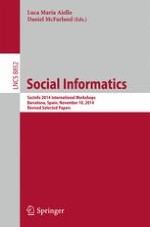This book constitutes the proceedings of the Workshops held at the International Conference on Social Informatics, SocInfo 2014, which took place in Barcelona, Spain, in November 2014. This year SocInfo 2014 included nine satellite workshops: the City Labs Workshop, the Workshop on Criminal Network Analysis and Mining, CRIMENET, the Workshop on Interaction and Exchange in Social Media, DYAD, the Workshop on Exploration of Games and Gamers, EGG, the Workshop on HistoInformatics, the Workshop on Socio-Economic Dynamics, Networks and Agent-based Models, SEDNAM, the Workshop on Social Influence, SI, the Workshop on Social Scientists Working with Start-Ups and the Workshop on Social Media in Crowdsourcing and Human Computation, SoHuman.
